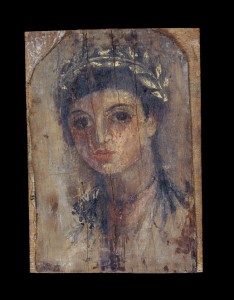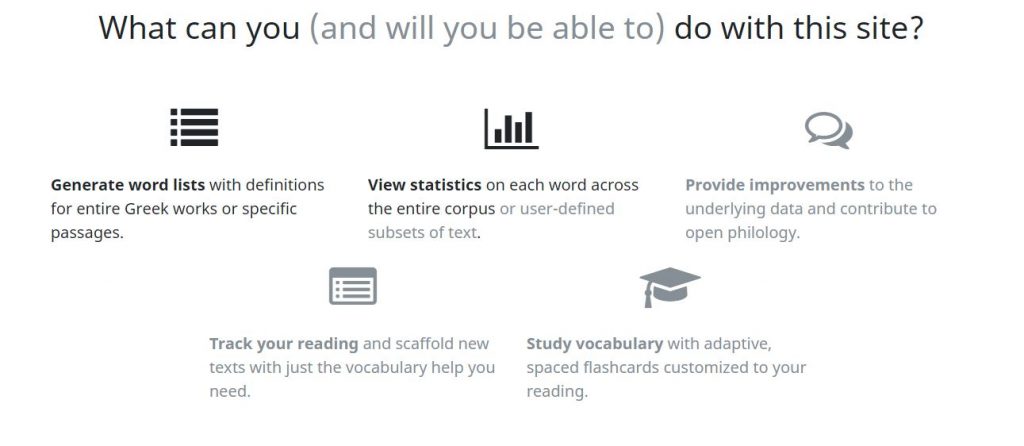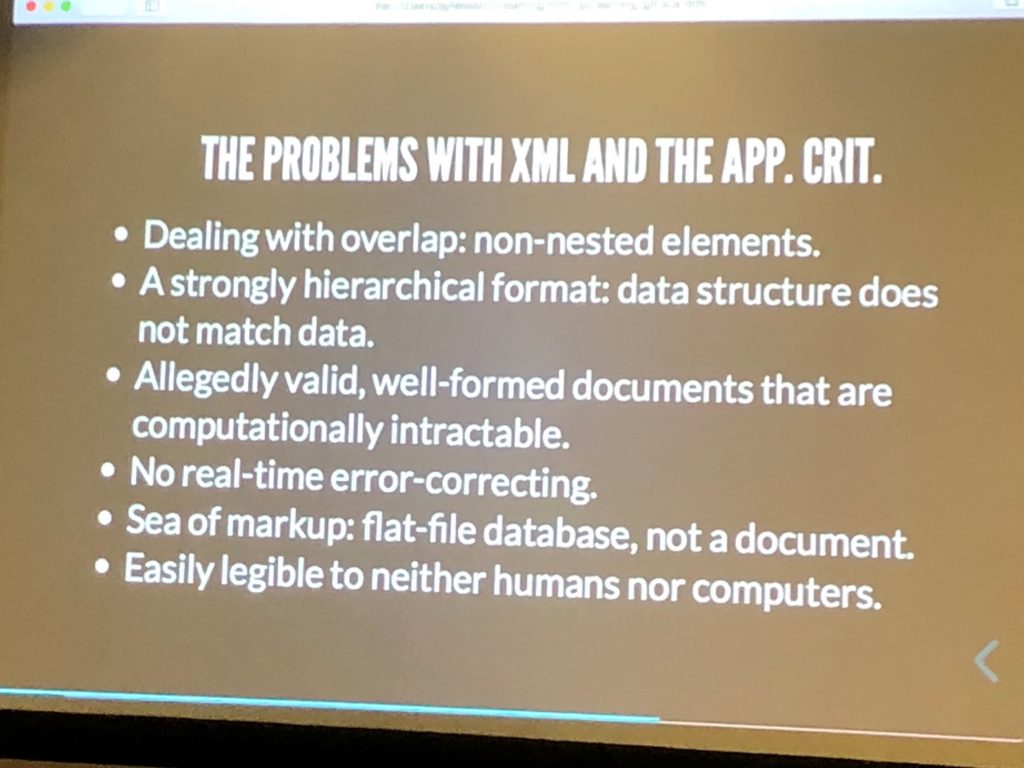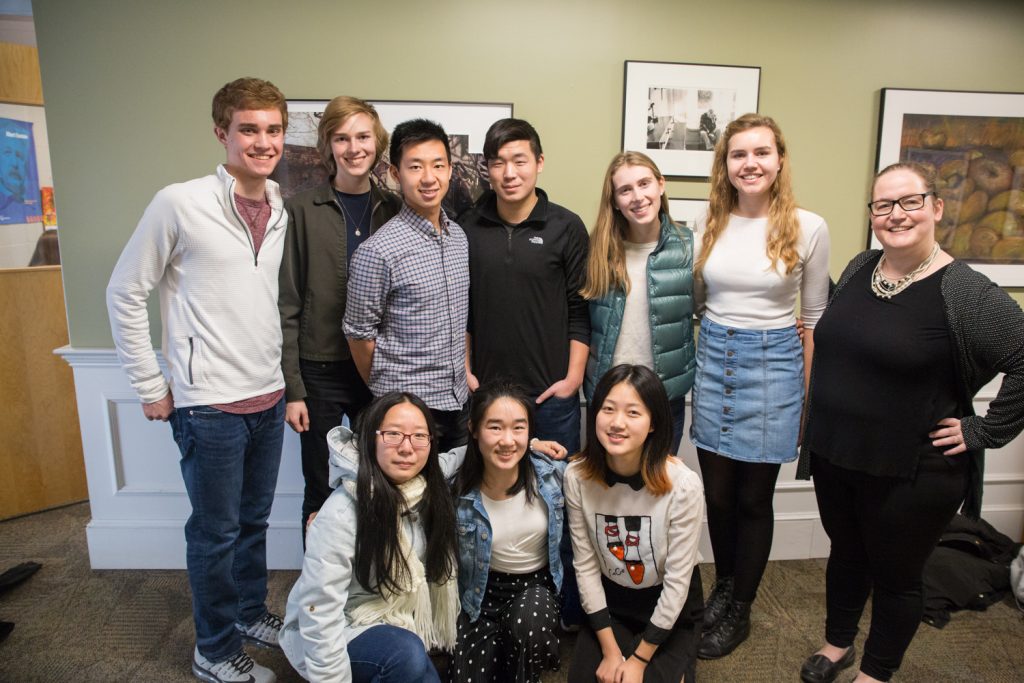Catullus is one of the most frequently translated of Latin poets, but when it comes to English versions suitable for classroom use (that is, reasonably close to the Latin, not seriously dated, and widely available) there are three:
All three have introductions and notes. The versions of Lee and Green include the Latin on facing pages.

Mummy Portrait of a girl, AD 50-70, Roman Egypt. Image © The Trustees of the British Museum
In my opinion Green’s is by far the best of the three, and this is also the verdict of Stephen Willetts in his long review article comparing the versions of Green, Lee, David Mulroy and Martin.[1] Green is an English-born classicist and writer, and a veteran translator of Ovid, Juvenal, and other classical authors. His version of Catullus is vigorous, frank, and often very clever. As some reviewers noted, however, both the translation and the notes assume an audience of advanced students or non-specialist scholars, and “will perhaps be less appealing to undergraduates or to the casual reader.”[2] It also leans heavily on sometimes outdated British slang, especially when it comes to the obscene poems (e.g., “little scrubber” for scortillum at 10.3, ditto for puella at 41.1, “whanger” for pene at 15.9, “rogering” for pedicare at 21.4, “one spent shag” at 10.22). While I myself love Green’s notes and extensive introduction—if you know some Catullus scholarship his treatments are masterpieces of concision and insight—I fear that students can’t always follow them. Some reviewers also came down hard on Green’s attachment to biographical interpretations, and his sometimes cavalier attitude toward scholars with whom he disagrees.[3] So those who wanted to use his introductory matter in a class on Roman literature, for example, would have to do some work to contextualize Green’s views.
Another aspect of Green that has to be reckoned with is his determination to imitate Catullus’ meters systematically in English accentual verse. He explains and defends this practice at length in the Introduction (pp. 24–32). His view, shared strongly by Willetts and Martin, though not by Lee, is that the Latin quantitative patterns both can be reproduced exactly using English word accent, and that the attempt to do so must be made, because “the rhythm, the beat, of a poem constitutes its essential musical core.” (27) To use a different meter is in his view “wholly misleading.” Willetts believes that all translators of Catullus must “lay out the exact forms of English rhythm and their variations that will represent quantitative meters,” and that “translators who fail that minimum requirement should not see print” (177).
While Green’s success in this endeavor is remarkable in its own terms, there is sometimes a cost in tone and word choice. His version of 1, for example, begins:
Who’s the dedicatee of my new witty
booklet, all fresh-polished with abrasive?
To render dono with “dedicatee” is to choose the wrong register. “Dedicatee” is a word from literary criticism, not from poetry, or even ordinary spoken English. But it helps Green get the metrical shape he insists on.[4] Martin, also striving to render the hendecasyllable in English, begins:
To whom will I give this sophisticated
abrasively accomplished new collection?
As with Green, the metrical imitation of the Latin is impressive, but the word choice problematic. To have Catullus begin by calling his own work “sophisticated” and “accomplished”— in his most literal meaning he is just referring to the elegant appearance of the physical book—is to make him sound self-satisfied and complacent. “Abrasively” for pumice is clever if you know the Latin, but unclear otherwise.
Lee’s version strives for a very concise, literal rendering, which often leads to a bland, rather dull effect:
Whom do I give a neat new booklet
Polished up lately with dry pumice?
This faithfully represents the sense of the Latin, but at a price. “Booklet” is technically correct for libellum, but hardly consistent with the main point, that the physical object looks lovely. In the name of economy and respect of the literal meaning of the text, Lee often under-translates in this way, as with “love neat,” for merum amorem (13.9), which is obscure if you don’t know the Latin, or “talent” for talentum in 12.8, also obscure, since the reference to the ancient monetary unit is unexplained. “Attend Thetis’ nuptial torches” is a typically over-literal rendering of Thetidis taedas celebrare iugalis (64.302). I can imagine assigning Lee’s version to students if I want them to know what Catullus says, but not if I want them to understand what makes Catullus enjoyable. And he too tends to rely on British slang in a way that may be off-putting for American readers (“I’ll bugger you and stuff your gobs, / Aurelius Kink and Poofter Furius 16.1–2; “give a toss” for faceret pili 10.13).
I can understand why Green, Martin, and Willetts want to insist on accentual, metrical renderings. Catullus is a deft metrician, it seems like a betrayal not to bring this out in translation. They would see a “free verse” version as a serious dereliction of duty. As Martin puts it, “if your author is a high-wire walker, you are not going to be able to convey the excitement he generates by tiptoeing along a piece of string stretched out on the floor” (p. xxv). As the metaphor implies, on this view metrical verse is high and exciting, unmetrical verse, low and pedestrian.
Yet metrical form as a constraint by no means enjoys the unchallenged position in English poetry that it once did, and it need not be treated as a sine qua non. Even apart from the practice of today’s poets, students are not now weaned on exclusively metrical verse as they once were, and I doubt whether today’s student audience is even capable of perceiving Green’s metrical virtuosity. More importantly, Martin and the others overdraw the antithesis between metrical verse on the one hand, and everything else. Language is not unpoetic, commonplace, or low, just because it’s not metrical, as the practice of many distinguished English poets working today will attest. It is a mistake to privilege meter at the expense of other factors that go to produce a sense of elevation and freshness: density, economy, avoidance of cliché, and careful attention to sound.
These goals, along with the getting the right tone and diction, attaining readability and clarity, and arranging for the right emphasis, outweigh the importance of accentual metrics, and must not be sacrificed to it. In my personal hierarchy of priorities tone and level of diction rank first, which is why a word like “dedicatee” or “booklet” bothers me. A second absolutely paramount value for me is clarity and readability. It is imperative to use natural English syntactical patterns, and not to use a given grammatical structure simply because it corresponds to a Latin one. One should simplify complex Latin constructions, so long as that does not do serious violence to the shape of the poem. Willetts has harsh words for translators who over-simplify syntax for the sake of readability.[5] But one can tread a middle path. Close behind tone and syntactical clarity comes the matter of emphasis. Which words in the Latin are highlighted by virtue of the word order, syntax, or just by being unusual or significant in the context? The last four lines of 101, for example, contain a violent hyperbaton:
nunc tamen interea haec, prisco quae more parentum
tradita sunt tristi munere ad inferias,
accipe fraterno multum manantia fletu,
atque in perpetuum, frater, ave atque vale!
The purpose of this hyperbaton, as commentators point out, is to throw a spotlight on accipe, a crucial word that sums up the basic gesture of the poem. But the syntax is impossible in English. Lee moves the verb up for clarity:
But now, meanwhile, accept these gifts which by old custom
Of the ancestors are offered in sad duty
At funeral rites, gifts drenched in a brother’s tears,
And forever, brother, greetings and farewell. (Lee)
Martin keeps accipe where it is, but adds a new phrase, “I must celebrate grief”:
But now I must celebrate grief with funeral tributes
offered the dead in the ancient way of the fathers;
accept these presents, wet with my brotherly tears, and
now & forever, my brother, hail & farewell. (Martin)
Martin’s addition is an effective oxymoron, perhaps, but not Catullus. Green adds “here I offer,” which helpfully brings us back to the central point of the situation:
Still, here now I offer those gifts which by ancestral custom
are presented, sad offerings, at such obsequies:
accept them, soaked as they are with a brother’s weeping,
and brother, forever now hail and farewell. (Green)
In the version I wrote for the sourcebook on Roman Civilization published by Hackett in 2014, a book produced in collaboration with Scott Smith, I repeated the emphatic accipe, and broke the two couplets with a full stop:
So take these, at least for now, the dismal funeral gifts
our ancestral custom has handed down.
Take them, wet with your brother’s tears, and in eternity
hail and farewell, brother, hail and farewell.
This version introduces repetition to the final line, in an attempt to bring out the emphatic solemnity of the traditional phrase ave atque vale.
Another problem in these lines is nunc tamen interea. Rather bland and colorless in literal translation, in Latin these words poignantly emphasize the futility of the gesture Catullus is making. Lee, literal as always, settles for “But now, meanwhile.” Martin ejects interea completely in favor of his added phrase, which is a real shame. He probably disliked the prosaic feel of “meanwhile,” which did not bother Lee. Green’s “Still, here now” is a good solution, since it brings the important tamen to first position in the line, and separates it with a comma, so it can be properly felt. “Here” adds vividness in keeping with the context. My own approach was to put even more emphasis on nunc tamen interea by giving it a four word phrase, marked off by commas, but only after the verb. Having the verb first both enhances clarity and reflects the importance of the word.
Part of the job of getting Catullus to make sense to students is equipping the text with an introduction and notes. Martin’s introduction is very much in the traditional of belles lettres: “To paraphrase Paolo Pasolini on Ezra Pound, Catullus’ love of the purely phatic aspect of language, its function as chat, is one of the most extraordinary phenomena in classical literature” (p. xi). This is a nice insight, but I can’t imagine an average student getting much out of it. Not being a classicist he is naturally not up on all the scholarship regarding Catullus’ life and times, so when it comes to that topic his introduction is quite thin.
Lee’s introduction is heavily philological. He leads with a discussion of text transmission and emendation: “A very beautiful correction was that of Scaliger in 1577 . . .” (p. x), “Those three insertions were ejected by Lachmann for his edition of 1829 . . .” (p. xi). Then he has three pages on the structure of the collection, a subject of much philological inquiry. “But, it is objected, why do ancient grammarians never refer to Book I, II, or III of Catullus?” (p. xiv). Next comes a discussion of what genre Catullus falls into. This is a good topic to broach, but he does it with too much name-dropping and unexplained reference to classical authors. When he finally gets to discussing Catullus’ life, the material is excellent, but the overall impression is one of immense scholarly apparatus standing between reader and poems.
Green’s Introduction is outstanding, as I mentioned, and foregrounds the life and times of Catullus, as one should. But here too there is the casual assumption of a level of literacy that I think it is unwise to assume. “Obviously we can’t take what Catullus wrote about Caesar or Mamurra at face value, any more than we can Byron’s portraits of George III and Southey in ‘The Vision of Judgement,’ or Dryden’s of James II and the Duke of Buckingham in ‘Absalom and Achitophel’” (p. 1). The most disturbing thing to me about this sentence is that he has not explained who Mamurra is. In my view students are turned off by this kind of writing.
Martin’s notes are extremely short, sometimes nonexistent, and tucked inconspicuously in the back of the book. On the fascinatingly obscene 16 he says simply “C.’s threat [to sodomize Furius and Aurelius and force them to fellate him] would have struck his Roman audience as an altogether appropriate response to a dastardly provocation [criticizing Catullus’ verse as effeminate]: extremism in the defense of one’s virility was no vice.” This is not only speculative, but a culpable failure to interpret and contextualize.
All three of these translations seem to me to omit much-needed explanations of cultural data. None of them, for example, explains what gout is at 71.6. Martin’s translation of notho … Luna as “counterfeit Luna” is unexplained, likewise “coneyed Iberia” for Cuniculosae Iberiae (37.18). “Bawdyhouse barroom” for salax taberna could use both a better translation and a note about the culture of Roman tabernae, an important piece of background for the poem.
I have loved Catullus’ poetry as poetry since I was a teenager, but I tend to view him now also through the lens of Roman social history. He needs to be appreciated as a literary craftsman, but also seen for the fascinating insights he can provide into Roman culture, especially when it comes to gender, sexuality, religion, and culture in general—to read Catullus really well one needs to be part poet and part anthropologist. This is the borderland where the most interesting work on Catullus has been done in recent decades, by scholars such as William Fitzgerald, David Wray, Marilyn Skinner, Brian Krostenko, and Chris Nappa. A really effective introduction and set of notes would try to take advantage of this work and present it comprehensibly to an undergraduate and general audience.
It would be churlish to critique so sternly the work of these excellent translators and scholars without exposing my own efforts to scrutiny, so for those without access to Ancient Rome: An Anthology of Sources (Hackett, 2014), here are a few of the translations printed there (pp. 24–33):
1
Here it is, my neat new collection
polished at the roll-ends with dry
pumice—but on whom to bestow it?
You, Cornelius.[6] For you always said
my foolishness amounted to something,
even as you were chronicling
the whole of history (three books!),
the only man of Italy with the guts to do it.
Gods! the learning and labor in that work.
So here, accept this, for what it’s worth.
Patron Muse, I pray, may it endure
for more than a single generation.
16
Fuck you both up the ass. Suck my cock,
Furius, Aurelius, you asshole faggots.
You dare to infer from my verse—
a little risqué and soft, it is true—
that I do these lewd things myself?
A good and loyal poet must be chaste
personally, but his verse need not be.
In fact, to have wit and a modicum of charm,
they must be a bit risqué and seductive,
the sort of thing to awake the loins,
and I don’t just mean in callow lads,
but in those old, hairy bastards
who normally just can’t get it up.
You two, you read of many thousand
kisses, and think I’m less than a man?
Fuck you both up the ass. Suck my cock.
101
Across many lands and across many seas I have traveled,
here now, brother, for your grim funeral rites.
I have come to bestow those final gifts we owe to death,
and to speak, in vain, to your silent ash.
Fortune has deprived me of your living presence, oh my
wretched brother, cruelly stolen from me.
So take these, at least for now, the dismal funeral gifts
our ancestral custom has handed down.
Take them, wet with your brother’s tears, and in eternity
hail and farewell, brother, hail and farewell.
[1] “Translating Catullus,” Arion 14.2 (2006-07), 155–178, at p. 177.
[2] Elizabeth Sutherland, Classical Journal 102 (2006-2007), 137.
[3] Roger Rees, Classical Bulletin 82 (2006), 144-146.
[4] Other examples: “colleague” for sodalis in 10.29; “queening Arabs” for Arabesve molles in 11.5; “gallants” for moechis in 11.17.
[5] “In a poem as long, intricate, and verbally radiant as Catullus 64, there is no excuse for translators like Mulroy to break the poet’s verse periods into a necklace of stunted, independent clauses strung on a cord of newspaper syntax. It is time for translators to take a long step back from the process of extreme domestication and school themselves in the music of a flexible syntax that can breathe freely over a long sweep of lines and react in counterpoint with the rhythmic movement of the verse” (p. 167). Fair enough, but the goal must be a natural English syntax one can find in modern certified translations, not an imitation-Latin syntax.
[6] Cornelius Nepos, a fellow northern Italian, an intimate friend of Cicero, and a distinguished author in his own right.
 I am teaching the film Agora (2009) for the second time this year in my class Ancient Worlds on Film. Despite some considerable hunting I have not been able to find a convenient collection of the ancient sources on the fascinating philosopher and mathematician Hypatia of Alexandria, the subject of the film. Since comparison of film and ancient sources is at the heart of the course I was constrained to make my own collection, which I offer here for the benefit of anybody else interested in the film. In include Rufinus’ account of the storming of the temple of Serapis, which figures prominently in the film. I also put in accounts of Hypatia from both Christian (John of Nikiu, Socrates) and pagan or Neo-Platonist (Palladas, Damascius, the Suda) perspectives. The main gap is the letters of Synesius, which I did not include. For more on Hypatia and the film, I recommend the following:
I am teaching the film Agora (2009) for the second time this year in my class Ancient Worlds on Film. Despite some considerable hunting I have not been able to find a convenient collection of the ancient sources on the fascinating philosopher and mathematician Hypatia of Alexandria, the subject of the film. Since comparison of film and ancient sources is at the heart of the course I was constrained to make my own collection, which I offer here for the benefit of anybody else interested in the film. In include Rufinus’ account of the storming of the temple of Serapis, which figures prominently in the film. I also put in accounts of Hypatia from both Christian (John of Nikiu, Socrates) and pagan or Neo-Platonist (Palladas, Damascius, the Suda) perspectives. The main gap is the letters of Synesius, which I did not include. For more on Hypatia and the film, I recommend the following:





